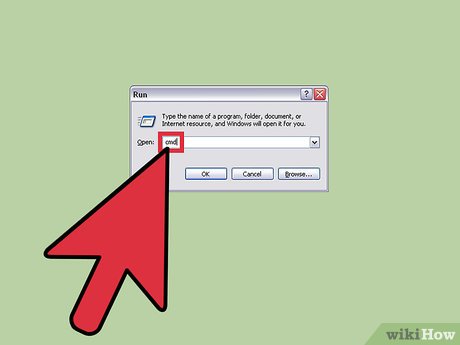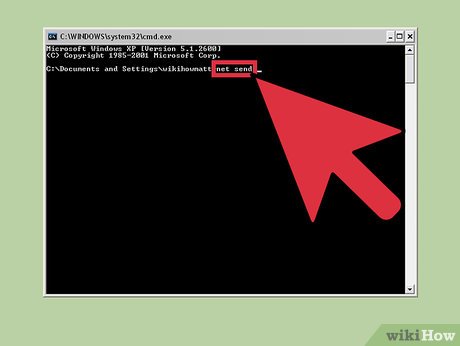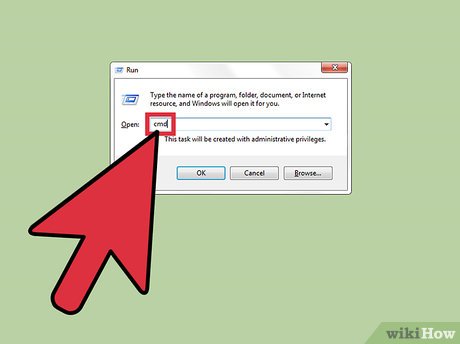How to Use the Net Send command
On Windows XP

Open Command Prompt. You can use commandnet sendto send messages to other computers on the network. This command is entered through Command Prompt. You can open Command Prompt from the Start menu or press ⊞ Win+ Rand then type "cmd".
If you are using Windows Vista, 7, 8, 8.1 or 10, see the next section. Commandnet sendis no longer integrated from Windows Vista onwards and is replaced by the commandmsgwith similar features.

Start command. Enter net sendthen press space. Information will be added to the end of the command to specify the content and destination of the message.

Determine the audience to whom you will send the message. There are a few different ways you can send messages to specific users or entire groups:
net send name– You can enter the name of a user or computer on the network to send a message to a specific audience. If the username has spaces, enclose the name in quotation marks (for example, net send "Le Thao").
net send *– This command will send a message to all users on the current domain or workgroup.
net send /domain:name- This command will send messages to people in a specific workgroup or domain.
net send /users- This command will send a message to all users currently connected to the server.

Add message. Enter the message you want to send after specifying the recipient. Your message can contain up to 128 characters.
For example: net send "Le Thao" 10 phut nua gap nhau nhe.

Send Message. After composing the message, click ↵ Enterto send. Subjects will receive messages in Windows dialog boxes, as long as they are logged in and connected to the network.
On Windows Vista and later

Check if your version of Windows supports the commandmsgor not. After stopping command integrationnet send, Windows replaced it with the commandmsgwith a lot of similar functions. Unfortunately the ordermsgAvailable only on Professional and Enterprise editions of Windows. If you are using the Home version, you will need to upgrade to Professional or Enterprise to use the commandmsg.
You can see which version of Windows you're using by pressing ⊞ Win+ Pauseor right-clicking "Computer" and selecting "Properties." Your version of Windows will appear below the "Windows edition" section.

Open Command Prompt. Similar tonet send, commandmsgcan also be executed from Command Prompt. You can press the key ⊞ Winand enter "cmd" to open the program, or apply other methods depending on your current Windows version.
On Windows 7 and Vista – You open Command Prompt from the Start menu.
On Windows 8.1 and 10 – Right-click the Start button and select "Command Prompt".
On Windows 8 – Press ⊞ Win+ Xthen select "Command Prompt".

Start command. Enter msgthen press Space. Then add the destination information as well as the message content at the end of the command.

Determine the audience that will receive the message. CommandmsgThere are several route options other than the commandnet sendbefore:
msg username– Enter a network user name to send a message to that user.
msg session– Enter the name of the specific session you want to send the message to.
msg sessionID- Enter the number of the specific session you want to send the message to.
msg @filename– Enter the name of the file containing the list of user names, sessions and/or session numbers to which you want to send the message. This method is suitable for lists of departments.
msg *- This command will send a message to everyone who is on the server.

Specify the recipient's server to which you want to send the message (optional). If you want to send a message to someone on another server, enter the server information after the recipient information. If you do not specify a server, the message will be sent on the current server.
msg * /server:servername

Set a time limit (optional). You can add display seconds for time-restricted information. Time settings are added after the server information (if available).
msg * /time:seconds(e.g. a 5 minute time limit would be 300 seconds)

Add message. After setting all the options, you can add the message text to the end of the command. You can also press ↵ Enterwithout entering a message, then the system will prompt you to enter the message content on a separate line.
For example:msg @salesteam /server:EASTBRANCH /time:600 Chuc mung moi nguoi da hoan thanh chi tieu cua quy!

Send Message. Click ↵ Enterto send the message. Other users will receive the message immediately.
Commandmsgdesigned to send messages to terminal users, not necessarily other Windows computers on the same network.

Troubleshoot. There are some errors that you may encounter when using the commandmsg:
'msg' is not recognized as an internal or external command, operable program or batch file– If you receive this message, it means the version of Windows you are using does not support the commandmsg. You need to upgrade to the Professional version to execute this command.
Error 5 getting session namesorError 1825 getting session names– There was a problem sending the message. Some users have resolved this issue by opening the Registry Editor on the recipient's computer (run "regedit" to open), accessing the path "HKEY_LOCAL_MACHINESYSTEMCurrentControlSetControlTerminal Server" and changing "AllowRemoteRPC" from "0" becomes "1".
You should read it
May be interested
- Command at in Windows
 the at command schedules commands and programs to run on a computer at a specified time with a specific date. you can only use the command at when schedule service is running.
the at command schedules commands and programs to run on a computer at a specified time with a specific date. you can only use the command at when schedule service is running. - Doskey command in Windows
 the doskey command calls doskey.exe (which reminds of previously entered command lines), modifies the command line and creates macros.
the doskey command calls doskey.exe (which reminds of previously entered command lines), modifies the command line and creates macros. - 10 useful commands in Windows you should know
 command prompt is used to execute batch files, perform tasks quickly, help you troubleshoot and solve some windows problems when the system crashes. however, not all commands in windows are useful and must be done regularly. with the 10 command lines in the following article it is very useful even if you are not an administrator.
command prompt is used to execute batch files, perform tasks quickly, help you troubleshoot and solve some windows problems when the system crashes. however, not all commands in windows are useful and must be done regularly. with the 10 command lines in the following article it is very useful even if you are not an administrator. - How to use the which command in Linux
 the which command in linux determines the executable binary, which will execute when you issue a command to the shell. if you have different versions of the same program on your computer, you can use which to find out which shell will use.
the which command in linux determines the executable binary, which will execute when you issue a command to the shell. if you have different versions of the same program on your computer, you can use which to find out which shell will use. - The command reg add in Windows
 the reg add command adds new subkeys or entries to the registry.
the reg add command adds new subkeys or entries to the registry. - Exit command in Windows
 the exit command exits the cmd.exe program (command interpreter) or the current batch script. to learn how to use this command, please see the example below.
the exit command exits the cmd.exe program (command interpreter) or the current batch script. to learn how to use this command, please see the example below. - Rem command in Windows
 the rem command helps write comments (comments) in a batch file or config.sys.
the rem command helps write comments (comments) in a batch file or config.sys. - The dd command in Linux, How to use the dd command
 dd is a command line utility for unix-like and unix operating systems, with the main purpose of converting and copying files.
dd is a command line utility for unix-like and unix operating systems, with the main purpose of converting and copying files. - How to use Xcopy command in Command Prompt
 knowing how to use xcopy command in command prompt, you will easily use commands in cmd professionally. in particular, the xcopy command is extremely useful for those who copy and copy data on the computer.
knowing how to use xcopy command in command prompt, you will easily use commands in cmd professionally. in particular, the xcopy command is extremely useful for those who copy and copy data on the computer. - 20+ essential Linux security commands
 here are some of the most important security commands for everyday work on linux systems. if you're interested in security issues on your linux system, don't ignore these helpful security commands.
here are some of the most important security commands for everyday work on linux systems. if you're interested in security issues on your linux system, don't ignore these helpful security commands.










 How to Activate Windows XP without a genuine product key
How to Activate Windows XP without a genuine product key How to Install Windows Vista Operating System
How to Install Windows Vista Operating System How to Create and Delete Files or Folders from Windows Command Prompt
How to Create and Delete Files or Folders from Windows Command Prompt How to Change Language in Windows 7
How to Change Language in Windows 7 How to Enable Photo Previews in Folders (Windows 10)
How to Enable Photo Previews in Folders (Windows 10) How to Back Up Data
How to Back Up Data